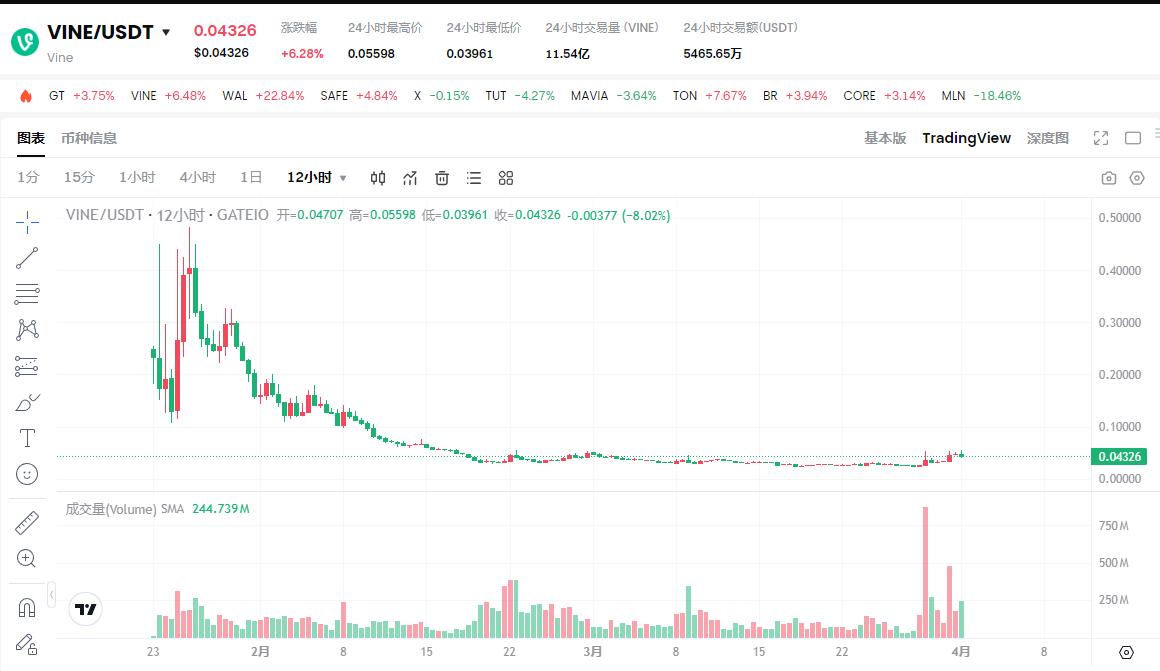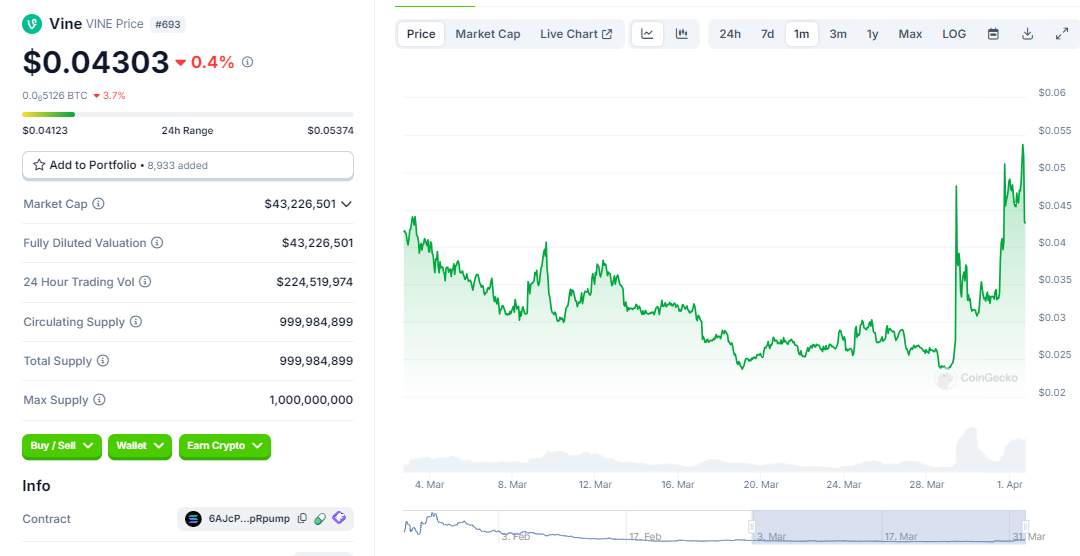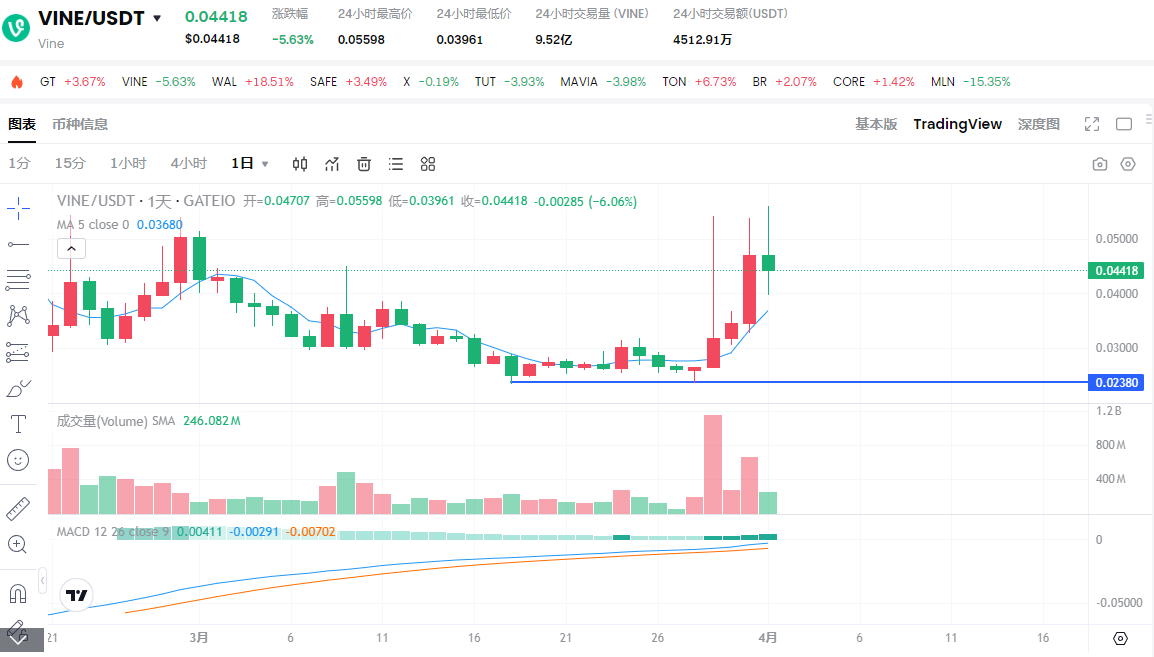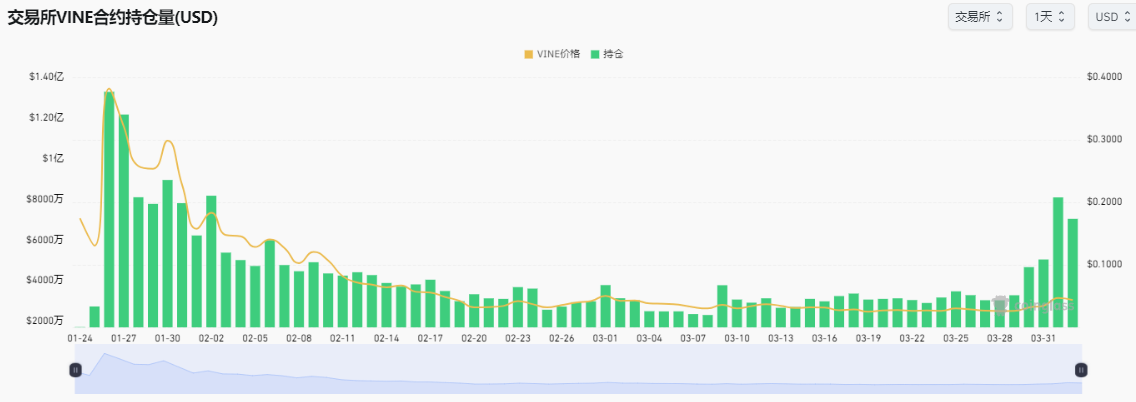Author: Alvis
I. The Origin of the Vine Token: A Collision of Nostalgic Marketing and Technological Narrative
From the Pioneer of Short Videos to a Crypto Legacy

The history of Vine dates back to 2012, when this platform for 6-second looping videos took the world by storm, inspiring applications like TikTok and Instagram Reels. Its co-founder, Rus Yusupov, although not directly involved in subsequent operations after selling Vine to Twitter (now X platform), remained deeply connected to this cultural symbol. In January 2025, as Musk hinted multiple times at "considering a restart of Vine," Yusupov issued a meme coin named VINE on the Solana chain in the name of "commemorating unity and creativity," instantly igniting market sentiment.
The Dual Narrative Strategy of the Founder
Yusupov's issuance statement is filled with idealistic tones: developer tokens are locked until April 20, 2025, profits are donated to the X platform, and it emphasizes "decentralized creative freedom." However, the market is more focused on the speculative value of his endorsement as the "Vine founder" and the potential connection to Musk. This combination of "emotional packaging + celebrity effect" became the core driving force behind VINE's early market capitalization soaring to $400 million.
The Boost from the Solana Ecosystem
Choosing to issue on the Solana chain, VINE precisely tapped into the industry trend of "high-performance public chains + meme coin explosion" in 2025. Solana's low gas fees and high TPS characteristics lowered the participation threshold for retail investors, while the on-chain AI and social protocol craze provided VINE with the imaginative space of a "Web3 version of a short video platform."
II. The Roller Coaster Market of the Vine Token: A Three-Way Game Among Whales, Exchanges, and Retail Investors
The "Fast Track Myth" in the Early Days

On January 23, 2025, within an hour of its launch, VINE's market capitalization surpassed $100 million, and then briefly surged to $240 million due to Yusupov's public lock-up commitment. During this phase, market narratives focused on the possibility of "Musk restarting Vine," while on-chain data showed that the top ten holders accounted for as much as 39.52%, indicating a clear whale control characteristic.
The Bloody Harvest in the Contract Market
After VINE was listed on Binance contracts on January 26, the plot took a sharp turn. The short-selling funding rate remained negative, and the whales reversed the market, causing a 300% liquidation of short positions, followed by selling off the spot and opening short positions, completing a "double kill" of longs and shorts. This harvesting strategy, designed using the transparency of exchange data, directly led to the price plummeting from $0.43 to $0.26, trapping many retail investors who chased the highs.
Pulse Market Driven by Musk's Dynamics
On March 29, the Polymarket prediction platform released news of "Musk approving the restart of Vine," causing VINE to surge 90% again, but it subsequently retraced. This "news-driven volatility" exposed the fundamental flaw of the project: the price was decoupled from substantive progress and completely relied on external event stimuli.
III. The Current Situation After a 10-Fold Crash: Value Reassessment and Ecological Dilemma
Data Insight: Liquidity Crisis and Chip Distribution

As of April 1, VINE's price has dropped over 90% from its historical peak, with Vine priced at $0.043 and a circulating market cap of less than $44 million, while the 24-hour trading volume shrank to $83 million. More critically, the on-chain holding concentration has not significantly improved, with the top ten addresses still controlling over 40% of the supply.
Stagnation in Ecological Progress: A Warning of Narrative Failure
Although Yusupov claimed that "VINE will empower decentralized short video creation," the actual implementation has been zero. The project's official website has not disclosed any technical roadmap, and the so-called "donation of profits to the X platform" lacks transparent auditing. Meanwhile, Musk's ambiguous attitude towards the restart of Vine (with Polymarket predicting only a 26% probability) further undermined the credibility of the narrative.
Diverging Attitudes of Exchanges: The Emergence of a Liquidity Trap
Despite VINE being listed on top exchanges like Binance and OKX, the platforms have recently not prioritized it as a key operational target. For instance, after the launch of VINE's leverage and contract features on OKX, trading volume has continued to decline, and some exchanges have removed it from their homepage recommendations.
IV. Bottom-Fishing Logic Dissection: Quantitative Assessment of Risk-Reward Ratio
K-Line Cycle Reveals "Golden Pit" Opportunities

From a technical analysis perspective, VINE's daily RSI has dropped to 22 (severely oversold range), and the MACD histogram has shown a bottom divergence signal, with similar historical patterns averaging a rebound of 380%. The weekly support level is in the $0.018-$0.022 range, and the previous price ($0.025) has entered an extremely undervalued area of "breaking net present value." Currently, Vine has broken above the 5-day moving average, and the MACD shows bullish signals.
Fundamentals: The Possibility of Narrative Restart
The key variable is whether Musk will release a clear positive signal before April 20 (the token unlock date). If Vine 2.0 is indeed tied to the VINE token economic model, it could trigger short-term FOMO; conversely, the unlocking selling pressure will exacerbate the decline. It is important to note that Yusupov's lock-up commitment only covers 5% of the tokens, while the remaining 95% can still circulate freely.
Community Consensus "From Dispersed to Concentrated"
Although Twitter discussions have decreased by 87% from their peak, two positive changes have emerged in the core community:
- Increased holding concentration: The top 100 addresses' holdings have risen from 39.5% to 52.3%, reflecting whale bottom-fishing activity.
- Increased developer activity: GitHub shows that the Vine 2.0 code repository had 127 commits in the past week, involving key modules like "AI video editing tools" and "on-chain copyright agreements."
Institutional Entry Signals: Exchanges and Capital Under Currents
Within two months of VINE's launch, it has been listed on top exchanges like Binance and OKX, with contract trading volume peaking over $500 million. On-chain data shows that market makers Wintermute and Amber Group have recently continued to increase their holdings of VINE, with positions reaching 1.2 million and 800,000 tokens respectively (valued at approximately $480,000 / $320,000), indicating that professional capital is optimistic about the bottom value.

Additionally, Coinglass data shows that the Vine contract holding volume exceeds $70 million, far surpassing Vine's current circulating market cap.

Vine's funding rate has exceeded -0.05%, and combined with the recent surge in holding volume, the possibility of whales using the contract market to short-sell cannot be ruled out.
Conclusion
When the market labels VINE as a "zero-value coin" out of panic, real opportunities often quietly emerge. The current price of $0.04 for Vine is worth bottom-fishing. Whether it is Musk's resource endowment, Solana's technological dividends, or the wave of meme coins transforming into practical tokens, VINE has already occupied a scarce ecological niche. For rational investors, this "moment of fear" is an excellent window to position for future alpha.
免责声明:本文章仅代表作者个人观点,不代表本平台的立场和观点。本文章仅供信息分享,不构成对任何人的任何投资建议。用户与作者之间的任何争议,与本平台无关。如网页中刊载的文章或图片涉及侵权,请提供相关的权利证明和身份证明发送邮件到support@aicoin.com,本平台相关工作人员将会进行核查。




